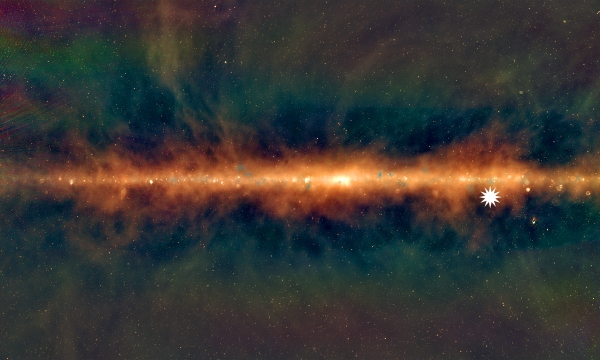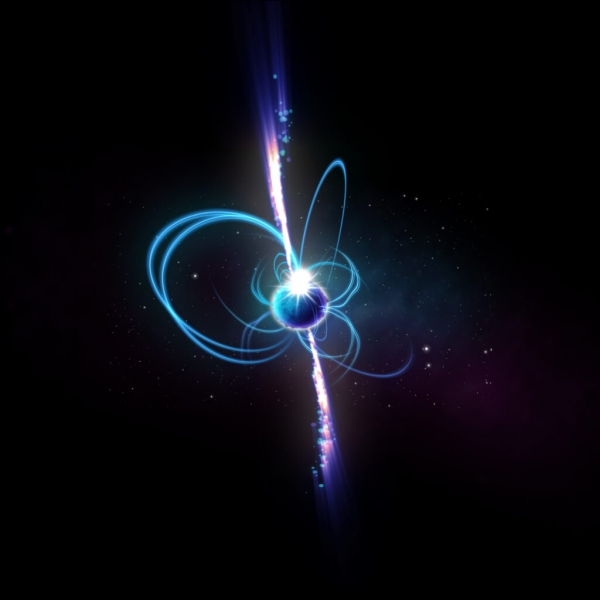Every time we look in a new place, which in astrophysics often means bringing new tools online, we find something unexpected. The news that an object has been detected that, for one minute in every 18, becomes one of the brightest radio sources in the sky, continues the series of surprises we’ve been racking up ever since first Galileo put eye to telescope. So what is this object, and why is it cause for such interest?
Here’s astronomer Natasha Hurley-Walker (Curtin University/International Centre for Radio Astronomy Research), who is lead author of the paper on the discovery:
“This object was appearing and disappearing over a few hours during our observations. That was completely unexpected. It was kind of spooky for an astronomer because there’s nothing known in the sky that does that. And it’s really quite close to us—about 4000 lightyears away. It’s in our galactic backyard.”

Image: A new view of the Milky Way from the Murchison Widefield Array in Western Australia, with the lowest frequencies in red, middle frequencies in green, and the highest frequencies in blue. The star icon shows the position of the mysterious repeating transient. Credit: Dr Natasha Hurley-Walker (ICRAR/Curtin) and the GLEAM Team.
Transients are nothing new to astronomers, but they usually don’t appear in this configuration. Pulsars can appear to flash on and off on cycles of milliseconds or even seconds, a fact that originally caused a flutter of SETI excitement when Jocelyn Bell (now Jocelyn Bell Burnell) and team went to work identifying their origin in November of 1967. The discovery of multiple sources of this nature soon made it clear that LGM1 (Bell’s joking reference to possible ‘little green men’) needed a less sensational name.
Slower transients are also common, the most obvious being supernovae, which can put on a celestial show before doing a slow fade that can take months. What distinguishes the new object is that it flashes on and off on a scale of minutes. It’s also emitting highly polarized radio waves, an indication that it possesses a strong magnetic field. Hurley-Walker suggests the possibility of an ‘ultra-long period magnetar,’ which would be a slowly spinning neutron star, and an unusually bright one at that.
Magnetars are neutron stars possessing a strong magnetic field. In an email exchange with Dr. Hurley-Walker, I learned that about 30 magnetars are currently known, most of them detected through X-ray observations. Most of these spin with periods between 1 and 10 seconds, and six of them have an unusual property: They flare suddenly at X-ray wavelengths and follow this with radio emission that can last for weeks, even months afterwards.
Several puzzling things leap out about the new discovery, as Hurley-Walker explained:
How is it producing radio waves, when it is spinning so slowly that it shouldn’t have enough energy? Are its magnetic fields getting twisted and it’s producing temporary emission like a radio magnetar?
How did it get to be so slow — if it aged “normally”, then its magnetic field should also be quite weak by now, in which case how is it producing radio emission?
How is it so bright, as bright as the youngest pulsars we know?

Image: An artist’s impression of what the object might look like if it’s a magnetar. Magnetars are incredibly magnetic neutron stars, some of which sometimes produce radio emission. Known magnetars rotate every few seconds, but theoretically, “ultra-long period magnetars” could rotate much more slowly. Credit: ICRAR.
The Murchison Widefield Array is unusually useful not only for studying this original find but also in looking for other objects that seem to be in the same category. Remember that the MWA is a precursor for the multinational Square Kilometre Array, which will connect radio telescopes in Western Australia and South Africa. The MWA is a low-frequency radio telescope operating between 80 and 300 MHz at the future site of the SKA, and its low frequency capabilities open up intriguing possibilities.
For when it comes to transients, we have a world of options in the high-frequency radio sky, from the above-mentioned supernovae to accretion events of various kinds, but beyond the pulsars we’ve already examined and studies of galactic nuclei, the low-frequency sky has been relatively tame. The paper on this work points out, however, that these wavelengths are sensitive to polarized radio emission processes like those at work here, fertile terrain for chasing down new transients.
This source, as an evidently slow rotator, stands out as a new category of magnetar, and one that could establish a possible population of slow-spinning magnetars that may in fact turn up in archival data at the MWA itself. Finding out whether this is the case or if we’re looking at an odd, one-off detection will take considerable digging. All of the data the MWA has produced for close to a decade is available at the Pawsey Research Supercomputing Centre in Perth, which houses MWA system data.
That’s a massive dataset, but future observations are in the cards as well. In her email, Hurley-Walker pointed to the way forward:
The MWA is currently down for maintenance but I’m planning to observe this source when it comes back up, as well as the rest of our galaxy, to try to find more of these objects. The source itself seems to be quiet at the moment, and (as far as we know) has been except in those few months in 2018.

Image: Composite image of the SKA-Low telescope in Western Australia. The image blends a real photo (on the left) of the SKA-Low prototype station AAVS2.0 which is already on-site, with an artist’s impression of the future SKA-Low stations as they will look when constructed. These dipole antennas, which will number in their hundreds of thousands, will survey the radio sky at frequencies as low as 50Mhz. Credit: ICRAR, SKAO.
An object that can convert magnetic energy to radio waves at this level stood out in the MWA observations, and we can assume that if other such objects exist, they will turn up in large numbers once the SKA comes online, offering a thousand times the sensitivity. Meanwhile, Dr. Hurley-Walker has modified her MWA search strategy to more readily spot other such transients should they occur.
The paper is Hurley-Walker et al., “A radio transient with unusually slow periodic emission,” Nature 601 (26 January 2022), 526-530. Abstract.



The first activity on this telescope took place in 2005 with our expeditions to the region to place at first a single and later 3 antenna tiles. This was truly expeditionary radio astronomy, considering that there was no existing infrastructure at the time – even roads became impassable after 10 mm of rainfall. They were such exciting times and hinted that this branch of astronomy and likely all astronomy was staring in the face of a golden age. Assuming that we keep civilisation together for long enough, this golden age will be longer though than any before it. My PhD is based in this project and being an early member of the team (employee number two), I take pleasure of course in witnessing such discoveries.
Please keep us posted on your work, David, and thanks for checking in. A golden age indeed!
Thank you David it was interesting to read the short background story in your post here. But yes, remote location is preferred for this kind of study. And it must be great to make a nice discovery already as a student.
Is it possible to use an object like this for “darkfield astronomy”? I mean, looking at a patch of sky nearby and seeing if it brightens in phase with these pulses, in hope of revealing a rogue or distant planet lit by the beam?
Tongue-in-cheek, speculation.
Is this magnetar slow spin rate an artifact of ETI energy collection?
Magnetars are similar to neutron stars but emit much higher magnetic fields than pulsars. The assumption is that the 1-10 second pulses are similar to the higher frequency spin rates of pulsars, but are they?
The high magnetic field of a magnetar suggests a potential for energy collection. One can imagine orbiting energy collectors as equivalent to wires cutting a magnetic field and inducing currents. Thus the pulse rate could be an artifact of the number of collectors orbiting the magnetar.
Most magnetars are fully developed with enough collectors in a Dyson swarm to make it appear that the magnetar is spinning at a certain rate based on the gaps between each collector.
This new slow-spinning magnetar is due to the early construction of collectors, with just a small number of collectors.
[Note this is just tongue-in-cheek, as the data is not consistent with this concept. OTOH, couldn’t this be an alternative way to collect energy from neutron stars rather than harvesting photons from main-sequence stars? As I understand it, magnetars are theoretically short-lived, just about perfect for a civilization needing power at various way stations as they expand across the galaxy before their eventual demise. The orbiting collectors could self-destruct by falling onto the neutron star. Wouldn’t that be detectable rather like the material in WD spectra?]
Your speculation might be tongue-in-cheek, but you’re onto something here. This is indeed one case where we indeed would be able to detect the activity of another civ. And if such exist, there’s indeed some advantages of tapping in to the magnetic field of one magnetar – compared to getting energy from other objects.